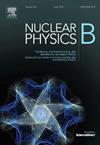Hidden conformal symmetry and holography for accelerating Kerr–Newman black holes
IF 2.8
3区 物理与天体物理
Q2 PHYSICS, PARTICLES & FIELDS
引用次数: 0
Abstract
We investigate the emergence of hidden conformal symmetry in the scalar wave equation for the accelerating Kerr–Newman black hole with arbitrary acceleration. By applying a near-horizon, low-frequency approximation, we reduce the quartic radial function to an effective quadratic form that reveals an underlying symmetry in the radial equation. This allows us to identify left- and right-moving temperatures and match the wave operator to the Casimir of a two-dimensional conformal field theory (CFT2). We compute the central charges from the near-horizon geometry of a near-extremal black hole and verify that the Cardy formula reproduces the Bekenstein–Hawking entropy. As further support for the Kerr/CFT correspondence in accelerating backgrounds, we analyze scalar field scattering and show that the absorption cross section agrees with the finite-temperature prediction from dual CFT2 correlators. Our results provide both thermodynamic and dynamical evidence that the near-horizon region of the accelerating Kerr–Newman black hole admits a consistent holographic description by using the Kerr/CFT correspondence.
加速Kerr-Newman黑洞的隐藏共形对称和全息
我们研究了任意加速Kerr-Newman黑洞标量波动方程中隐藏共形对称的出现。通过应用近视界低频近似,我们将四次径向函数简化为有效的二次形式,揭示了径向方程中潜在的SL(2,R)L×SL(2,R)R对称性。这使我们能够识别向左和向右移动的温度,并将波算符与二维共形场理论(CFT2)的卡西米尔相匹配。我们从接近极值黑洞的近视界几何计算中心电荷,并验证卡迪公式再现了贝肯斯坦-霍金熵。为了进一步支持加速背景下的Kerr/CFT对应关系,我们分析了标量场散射,并表明吸收截面与双CFT2相关器的有限温度预测一致。我们的研究结果提供了热力学和动力学证据,证明加速Kerr - newman黑洞的近视界区域允许使用Kerr/CFT对应进行一致的全息描述。
本文章由计算机程序翻译,如有差异,请以英文原文为准。
求助全文
约1分钟内获得全文
求助全文
来源期刊

Nuclear Physics B
物理-物理:粒子与场物理
CiteScore
5.50
自引率
7.10%
发文量
302
审稿时长
1 months
期刊介绍:
Nuclear Physics B focuses on the domain of high energy physics, quantum field theory, statistical systems, and mathematical physics, and includes four main sections: high energy physics - phenomenology, high energy physics - theory, high energy physics - experiment, and quantum field theory, statistical systems, and mathematical physics. The emphasis is on original research papers (Frontiers Articles or Full Length Articles), but Review Articles are also welcome.
 求助内容:
求助内容: 应助结果提醒方式:
应助结果提醒方式:


